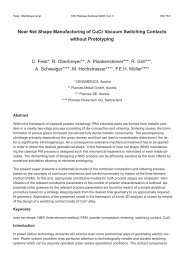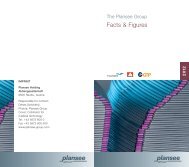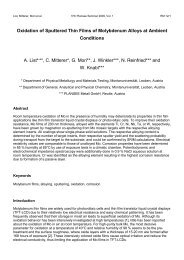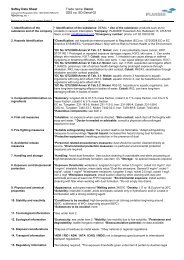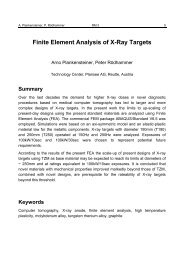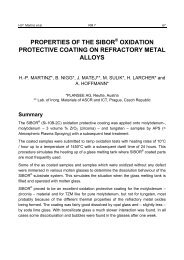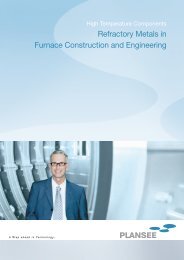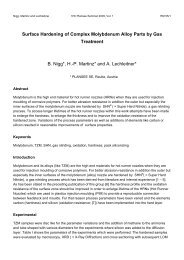Investigation of Solid Solution Hardening in Molybdenum Alloys
Investigation of Solid Solution Hardening in Molybdenum Alloys
Investigation of Solid Solution Hardening in Molybdenum Alloys
Create successful ePaper yourself
Turn your PDF publications into a flip-book with our unique Google optimized e-Paper software.
RM 18/2 17th Plansee Sem<strong>in</strong>ar 2009, Vol. 1 Wesemann, H<strong>of</strong>fmann et al.<br />
harden<strong>in</strong>g from the other strength <strong>in</strong>fluenc<strong>in</strong>g effects like particle harden<strong>in</strong>g, gra<strong>in</strong> boundary harden<strong>in</strong>g<br />
and texture. Comparable <strong>in</strong>formation about sample homogeneity and chemical composition is not<br />
available, too.<br />
<strong>Harden<strong>in</strong>g</strong> rate <strong>of</strong> Vickers hardness per 1at.% solute<br />
350<br />
300<br />
250<br />
200<br />
150<br />
100<br />
50<br />
0<br />
Semchyshen [2]<br />
Jaffee [1]<br />
Stephens & Witzke [3]<br />
Seigle [4]<br />
W V Re Ti Ta Al Cr Os Nb Zr Ir Fe Si Pt Co Ni Hf<br />
Alloy<strong>in</strong>g Element<br />
Fig. 1: Vickers hardness <strong>in</strong>crease per atomic % solutes reported by different authors [1] – [4]<br />
An <strong>in</strong>creas<strong>in</strong>g demand for tailored molybdenum alloys requires detailed <strong>in</strong>formation about the<br />
effectiveness <strong>of</strong> the <strong>in</strong>dividual strength <strong>in</strong>creas<strong>in</strong>g mechanisms <strong>in</strong> molybdenum. To make precise<br />
predictions about SSH <strong>in</strong> tailored molybdenum alloys it is <strong>in</strong>dispensable to know parelastic and dielastic<br />
<strong>in</strong>teractions result<strong>in</strong>g from the different solutes. Theories from Fleischer, Labusch and Suzuki try to<br />
expla<strong>in</strong> these two <strong>in</strong>teractions. Only little <strong>in</strong>formation is available which theory is most suitable for<br />
describ<strong>in</strong>g the SSH <strong>in</strong> molybdenum alloys.<br />
Therefore one major task <strong>of</strong> this work was to provide and <strong>in</strong>vestigate well def<strong>in</strong>ed solid solution alloys.<br />
Special attention was paid to the sample homogeneity <strong>of</strong> the solutes, presence <strong>of</strong> particles and the level<br />
<strong>of</strong> <strong>in</strong>terstitial impurities. The sample preparation is based on a powder metallurgical manufactur<strong>in</strong>g route.<br />
The amount <strong>of</strong> other non avoidable strength <strong>in</strong>fluenc<strong>in</strong>g mechanism like gra<strong>in</strong> size and texture has to be<br />
quantified and separated.<br />
Another object <strong>of</strong> the work was the comparison <strong>of</strong> different models describ<strong>in</strong>g SSH <strong>in</strong> molybdenum. After<br />
determ<strong>in</strong>ation <strong>of</strong> the <strong>in</strong>crease <strong>in</strong> strength caused by solid solution harden<strong>in</strong>g as well as the parelastic and<br />
dielastic <strong>in</strong>teraction parameters <strong>of</strong> the different theories were verified with respect to the best match<br />
between measured and calculated <strong>in</strong>crease <strong>of</strong> strength.<br />
Theoretical Considerations<br />
The strength <strong>of</strong> metals can be modified by work harden<strong>in</strong>g, solute atoms, gra<strong>in</strong> size, particles and the<br />
texture. In general a l<strong>in</strong>ear superposition <strong>of</strong> these strength determ<strong>in</strong><strong>in</strong>g mechanisms is assumed for pure<br />
metals.





